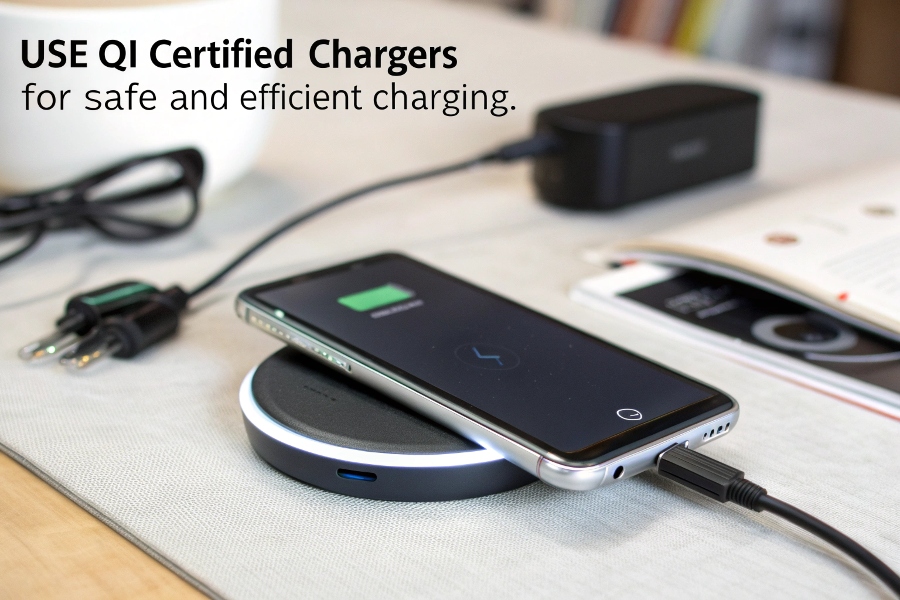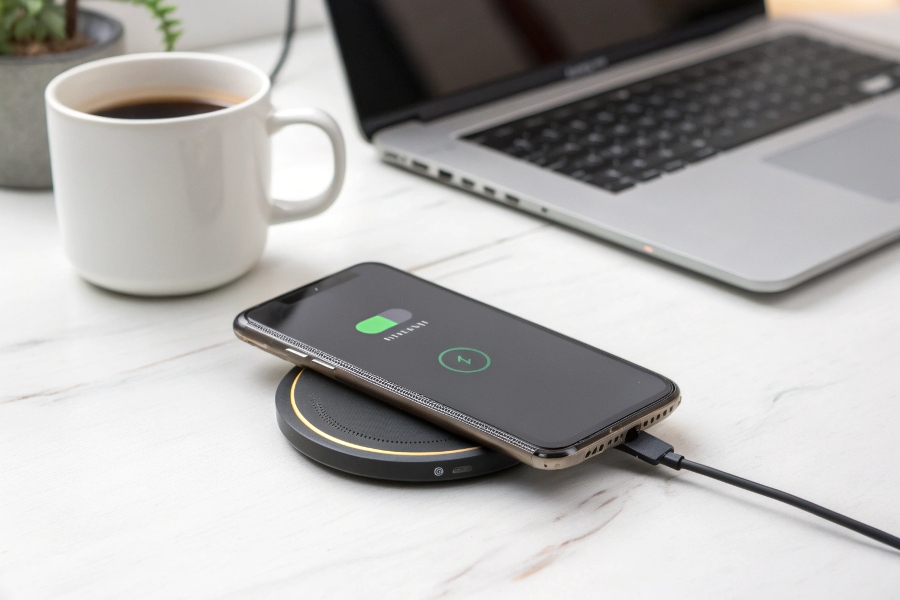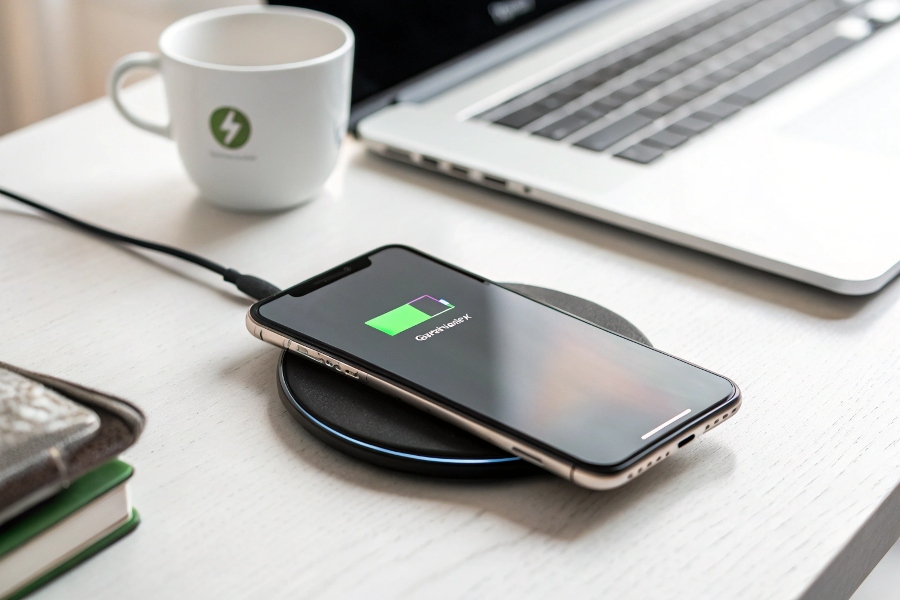Love plopping your phone on a wireless charger for convenience? But maybe you’ve heard whispers or worried yourself that this cable-free magic might be secretly harming your phone’s battery life faster than good old plugging in? Let’s get to the bottom of this.
Generally, no. Wireless charging itself isn’t inherently bad for your battery compared to wired charging when using quality equipment. The primary potential issue is excess heat generation, which can degrade batteries over time, but good chargers and smart usage minimize this risk effectively.

It’s a question I hear quite often, especially from busy folks like David who rely heavily on their phones and want them to last. The convenience is undeniable, but nobody wants to fork out for a battery replacement sooner than needed. The real villain in battery degradation isn’t typically the wireless method itself, but rather a common byproduct it can produce more of: excess heat1. Let’s dig into why heat matters so much.
Does wireless charging generate more heat than wired charging?
Noticed your phone feels a bit warmer after sitting on a wireless charger compared to being plugged in? Does this extra warmth signal trouble ahead for your battery’s longevity and overall health? Let’s compare the heat output directly.
Yes, wireless charging generally produces more heat than standard wired charging, especially compared to slower wired charging methods. The inductive energy transfer process used in wireless charging is inherently less efficient than a direct cable connection, meaning some energy is inevitably lost as heat.

Let’s break down why this happens. Wireless charging works using electromagnetic induction – a coil in the charger creates a magnetic field, and a coil in your phone converts that field back into electricity. It’s cool tech, but it’s not perfectly efficient. Think of it like trying to whisper across a room versus talking directly into someone’s ear; some energy gets lost along the way.
Why the Extra Heat?
The main reason is energy conversion loss. Every time energy changes form (electrical to magnetic field, magnetic field back to electrical), some is lost as heat. Wired charging has a direct electrical connection, minimizing these conversion steps and losses.
Factors Influencing Heat Generation
Several things can affect how hot your phone gets during wireless charging:
| Factor | Impact on Wireless Charging Heat | Mitigation Strategy |
|---|---|---|
| Charger Quality | High (Poor quality = more heat) | Use certified (Qi) chargers from reputable brands |
| Phone Alignment | High (Misalignment = more heat) | Center the phone carefully on the pad |
| Phone Case | Medium (Thick/metal cases trap heat/interfere) | Remove case or use a thin, wireless-compatible one |
| Ambient Temp | Medium (Hot room = more heat) | Charge in a cool, well-ventilated area |
| Charging Speed | Medium (Faster wireless = potentially more heat) | Phone/charger manage this via protocols |
At FUMEI, designing chargers that manage heat effectively is a huge part of our process. We focus on efficient components and thermal design because we know excessive heat is the enemy of battery longevity2. Those cheap, uncertified chargers David rightly avoids often cut corners here, leading to overheating. That overheating is bad for the battery. It’s not wireless charging per se, but inefficient and hot wireless charging that poses a risk.
How can I minimize potential battery damage from wireless charging?
Want to keep enjoying the ease of wireless charging without stressing about battery health? Concerned about that extra heat and want to protect your phone investment from premature aging? Here are straightforward steps you can take.
Minimize potential harm by using high-quality, Qi-certified charger3s, ensuring your phone is properly aligned on the pad, removing thick or metal cases before charging, and avoiding charging in direct sunlight or very hot environments. These simple habits significantly reduce excess heat buildup.

Protecting your battery while using wireless charging is mostly about managing heat and using the right equipment. Think about David’s concerns with supplier quality – the same applies to chargers. A little care goes a long way.
Choosing the Right Gear
Using a Qi-certified charger is probably the single most important step. Qi certification (managed by the Wireless Power Consortium) means the charger has been tested for safety, interoperability, and efficiency. While certification isn’t foolproof against all poorly made products, it’s a crucial baseline. Reputable brands invest in quality components and thermal management – things we prioritize at FUMEI to deliver that "worry-free charging" promise. Cheap, non-certified chargers are more likely to overheat or charge inefficiently, stressing your battery.
Smart Charging Habits
Beyond the charger itself, how you use it matters:
- Proper Alignment: Make sure your phone is centered on the charging coil. Misalignment forces the charger and phone to work harder, generating more heat for less efficient charging. Most chargers have indicators or shapes to help with this.
- Case Considerations: Thick, rugged cases, or cases with metal components (like pop sockets or magnetic mounts not designed for wireless charging pass-through) can trap heat or interfere with the magnetic field. This leads to inefficiency and more heat. If your phone gets noticeably hot, try removing the case.
- Cool Environment: Avoid charging wirelessly in direct sunlight (like on a car dashboard mount) or near heat sources. Heat is cumulative; adding charging heat to a hot environment stresses the battery more.
- Utilize Phone Features: Most modern smartphones (iPhones and Androids) have "Optimized Battery Charging" or "Adaptive Charging" features. Enable these! They learn your charging habits and slow down charging past 80% (especially overnight) until needed, reducing the time spent at high charge levels while potentially warm.
Following these tips allows you to benefit from wireless charging convenience while significantly mitigating the primary risk factor – excessive heat – thereby protecting your battery’s long-term health.
Conclusion
So, rest easy. Wireless charging isn’t inherently bad for your phone’s battery. Focus on managing heat by using quality Qi-certified chargers, smart placement, and avoiding hot environments to keep your battery healthy.
-
Learn about the impact of excess heat on battery health to better protect your device and extend its life. ↩
-
Explore expert tips on enhancing battery longevity to maximize your phone’s lifespan and performance. ↩
-
Understanding Qi certification can help you choose safe and efficient chargers, ensuring your device’s longevity and performance. ↩
